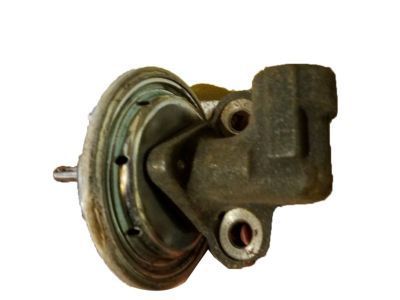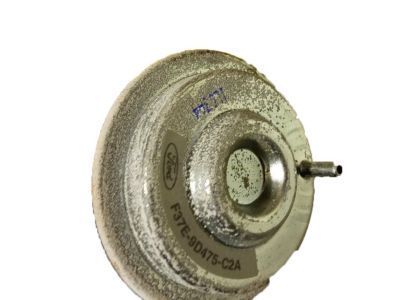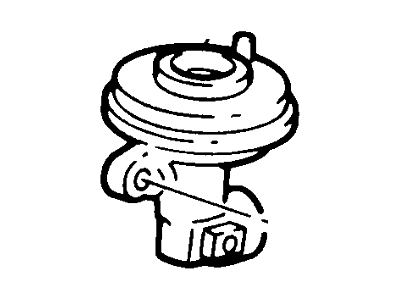Your vehicle deserves only genuine OEM Ford parts and accessories. To ensure reliability, purchase Ford part # F37Z-9D475-B Valve - Exhaust Gas with base parts number 9D475. It is sometimes referred to as Mercury EGR Valve. Our Ford parts and accessories are expedited directly from authorized Ford dealers strategically located all across the U.S. and are backed by the manufacturer's 12 month, 12,000 mile warranty. OEM Ford parts are the best for restoring your vehicle to factory condition performance. This part fits specific Mercury Mountaineer, Villager models.
Affordable, reliable and built to last, Ford part # F37Z9D475B Valve - Exhaust Gas stands out as the smart option. FordPartsGiant.com is your prime online source with the biggest and best selection of genuine Ford parts and accessories at giant discounted prices. We have the OEM Ford parts and accessories you need at the wholesale prices. FordPartsGiant.com has you covered no matter what type of Ford vehicle you drive. For detailed Mercury parts information, click here.
Make sure this part fits your vehicle
Mercury F37Z-9D475-B Valve - Exhaust Gas
1994-2002 Mercury F37Z9D475B

- Part DescriptionValve - Exhaust Gas Recirculation
- Base No.9D475
- ManufacturerFord
- Manufacturer's NotesThis part is discontinued.
Product Specifications
Brand Genuine Mercury Base No. 9D475 Manufacturer Part Number F37Z-9D475-B, F37Z9D475B Part Description Valve - Exhaust Gas Recirculation Manufacturer Note Valve assy. (E.G.R.) #F37E 9D475-B2A,B4A Item Dimensions 5.2 x 4.1 x 4.4 inches Item Weight 1.50 Pounds Condition New Fitment Type Direct Replacement Manufacturer Ford SKU F37Z-9D475-B Warranty This genuine Ford part is guaranteed by Ford's factory warranty. Shipping & Return Shipping Policy Return Policy Warning: California’s Proposition 65Vehicle Fitment
Year Make Model Engine Important vehicle option details 1997-2001 Mercury Mountaineer 6 Cyl 4.0L, 8 Cyl 5.0L 4AT 4R70W, 5AT 5R55E 1994-2002 Mercury Villager 6 Cyl 3.0L, 6 Cyl 3.3L 4AT 4F20E
Customer Questions & Answers
- Q:Is the the correct part for the attached VIN? Posted by FordPartsGiant Specialist
- A:You can Select Your Vehicle to check if F37Z-9D475-B fits your vehicle.Posted by FordPartsGiant Specialist
- Q:How does the ported vacuum valve operate in the emission control system for the 1986 Ford Bronco? Posted by Customer
- A:The ported vacuum valve operates based on ported vacuum and provides an ideal signal for EGR during part-throttle and cruise conditions.Posted by FordPartsGiant Specialist
- See expert answers on similar EGR Valve
- Q:How do you perform replacements of other components related to the air inlet control, deceleration throttle control, intake manifold heating, PCV system, and catalytic converter for the 1991 Ford Bronco? Posted by Customer
- A:Replacements of other components related to the air inlet control, deceleration throttle control, intake manifold heating, PCV system, and catalytic converter typically involve disconnecting wires and hoses, removing faulty components, and installing new ones as needed.Posted by FordPartsGiant Specialist
- See expert answers on similar EGR Valve
- Q:What are the components of the EGR system for the 2002 Ford Expedition? Posted by Customer
- A:The EGR system consists of components such as the EGR valve, EGR vacuum regulator, differential feedback pressure sensor, PCM (Powertrain Control Module), EGR pipe, and vacuum and pressure lines.Posted by FordPartsGiant Specialist
- See expert answers on similar EGR Valve
- Q:Why was the Backpressure valve system discontinued for the 1995 Ford Bronco? Posted by Customer
- A:It was discontinued due to the introduction of Electronic Engine Control (EEC) systems and their associated EEGR system.Posted by FordPartsGiant Specialist
- See expert answers on similar EGR Valve
- Q:How does the Exhaust Gas Recirculation (EGR) system address the issue of NOx production during lean cruise modes for the 1990 Ford F-250? Posted by Customer
- A:The EGR system reintroduces small metered amounts of exhaust gas back into the intake manifold during part throttle and cruise conditions, where it combines with the air/fuel mixture before combustion, lowering combustion temperatures and reducing NOx emissions.Posted by FordPartsGiant Specialist
- See expert answers on similar EGR Valve
- Q:What are the potential replacements for EGR system components, and what precautions are emphasized during EGR valve and passage cleaning for the 1997 Ford Explorer? Posted by Customer
- A:Potential replacements include the EGR valve, EGR vacuum regulator, and DPFE sensor. Safety precautions and protective gear are emphasized during EGR valve and passage cleaning to prevent damage.Posted by FordPartsGiant Specialist
- See expert answers on similar EGR Valve
- Q:What are some checks that can be performed to identify issues with the emission control system valves for the 1991 Ford F-250? Posted by Customer
- A:Checks for ported valves, integral back pressure transducer valve, and electronic EGR valves involve vacuum testing, leakage tests, functional tests, and resistance measurements.Posted by FordPartsGiant Specialist
- See expert answers on similar EGR Valve
- Q:How to remove and install Catalytic Converter, EGR Valve, EGR Valve Position Sensor and Vapor Canister on Ford F-250? Posted by Customer
- A:To perform maintenance on the EGR system components, start by disconnecting the battery's negative terminal. For the EVP sensor, located on the EGR valve, unplug the electrical connector, remove the three mounting bolts, and detach the sensor, ensuring to use a new O-ring during installation. The EGR Control (EGRC) or EGR Vent (EGRV) Solenoid requires disconnecting the battery, locating the solenoid(s) on the firewall, unplugging the electrical connector, labeling and detaching vacuum hoses, and removing the solenoid(s) by unscrewing the bracket screws. The EGR Vacuum Regulator (EVR) solenoid, located on the engine-mounted solenoid bracket assembly, involves detaching the battery cable, unplugging the sensor harness electrical connector and vacuum hose, and removing the solenoid. The EGR valve, for vehicles with EEGR, necessitates unplugging the electrical connector from the EGR valve position sensor, unscrewing the threaded fitting for external exhaust supply tube (if present), removing the vacuum line and mounting bolts, detaching the valve, and replacing the gasket. If replacing the EGR valve without the position sensor, transfer the sensor to the new valve with a new O-ring. For Thermactor system components, such as the TAB/AIRB or TAD/AIRD solenoid, disconnect the battery, locate the solenoid(s) on the firewall, unplug the electrical connector, label and detach vacuum hoses, remove the solenoid/bracket screws, and detach the solenoid(s). Air pump and control valves on MTA systems involve labeling and disconnecting hoses, replacing the faulty component, and reattaching hoses. For the air supply pump on MTA systems, loosen drivebelts, remove the faulty pump, label hoses, install the new pump, and adjust drivebelts. Replacement of check valves requires using a back-up wrench if connected to a steel air tube. Charcoal canister replacement involves removing a single mounting bolt, lowering the canister, detaching the hose, and reinstalling in reverse. Other component replacements, such as those related to the air inlet control, deceleration throttle control, intake manifold heating, PCV system, and catalytic converter, follow straightforward procedures of disconnecting wires and hoses, removing faulty components, and installing new ones as needed.Posted by FordPartsGiant Specialist
- Q:How to replace the EGR valve and other components in a Ford Excursion's EGR system? Posted by Customer
- A:The EGR system helps reduce oxides of nitrogen (NOx) by recirculating exhaust gases from exhaust ports through the EGR valve and back into the intake manifold, thereby lowering peak flame temperature during combustion. Models are equipped with the Electronic Exhaust Gas Recirculation (EEGR) system, which depends on the PCM for EGR control. The EGR flow rate is gauged by monitoring the pressure across a fixed orifice when exhaust gases pass through it, termed the Differential Pressure Feedback (DPFE) system. The system consists of the EGR valve, EGR vacuum regulator (EVR), Powertrain Control Module (PCM), differential feedback pressure sensor, EGR pipe, and various vacuum hoses. For EGR valve replacement, use the code stamped on its top when buying a new one. Turn the ignition OFF, remove the air filter housing, disconnect the EGR valve connector and vacuum hose, detach the EGR pipe, and remove the EGR valve retainer bolts. Clean the EGR valve gasket surface if reusing. For EGR pipe replacement, disconnect the vacuum lines from the DPFE sensor and the pipe at the manifold and valve. For the EVR, disconnect the electrical connector, label and detach vacuum hoses, and remove the regulator. For the DPFE sensor, disconnect the electrical connector, label and detach vacuum hoses, and remove the assembly. The 6.4L diesel engine uses two coolers for its EGR system, with the EGR valve located on top of the engine. It fits into a hole in the intake tract, sealed by an O-ring, and is attached with three bolts. Due to its tight fit, a special tool (Ford #303-1267) is required for removal, suggesting dealership involvement for replacements.Posted by FordPartsGiant Specialist
- Q:How does the EGR system accomplish its purpose for the 2001 Ford Ranger? Posted by Customer
- A:The EGR system accomplishes its purpose by recirculating a small portion of inert exhaust gases into the intake manifold. This lowers the combustion temperature and mitigates the formation of NOx compounds.Posted by FordPartsGiant Specialist
- See expert answers on similar EGR Valve
- Q:How do you replace the EGR valve for the 2001 Ford Ranger? Posted by Customer
- A:To replace the EGR valve, you need to follow these steps:1. Disconnect the negative battery cable.2. Remove the air cleaner outlet tube.3. Disconnect the EGR valve vacuum hose.4. Disconnect the EGR exhaust manifold tube.5. Remove the EGR valve from the intake manifold.6. Clean the gasket surfaces.7. Install the new valve.Posted by FordPartsGiant Specialist
- See expert answers on similar EGR Valve
- Q:What are the components of the EGR system for the 2008 Lincoln Navigator? Posted by Customer
- A:The EGR system consists of components such as the EGR valve, EGR vacuum regulator, differential feedback pressure sensor, PCM (Powertrain Control Module), EGR pipe, and vacuum and pressure lines.Posted by FordPartsGiant Specialist
- See expert answers on similar EGR Valve
If you have any questions about this product, please don't hesitate to ask us. We will be happy to help you!
Genuine Ford Part F37Z-9D475-B, the Right Choice
Why choose Ford Parts Giant
- Dedicated Service
Your complete satisfaction is our #1 goal
- Lowest Prices
Best deals on genuine OE parts from dealerships
- Fast Delivery
Orders are processed and delivered promptly












